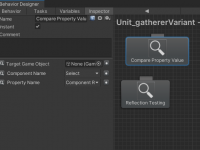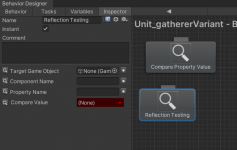I have seen that the `Invoke Method` task has a very smart selection capability in the editor.
It allows to first select a Game Object, and then the Component Name Magically adapts to only show possible component names of the currently selected GO.
In the implementation of the `Invoke Method` the `Component Name` property is a simple `SharedString`.
How is this special behaviour in the editor achieved?
Any advice would be appreciated.
It allows to first select a Game Object, and then the Component Name Magically adapts to only show possible component names of the currently selected GO.
In the implementation of the `Invoke Method` the `Component Name` property is a simple `SharedString`.
How is this special behaviour in the editor achieved?
Any advice would be appreciated.

